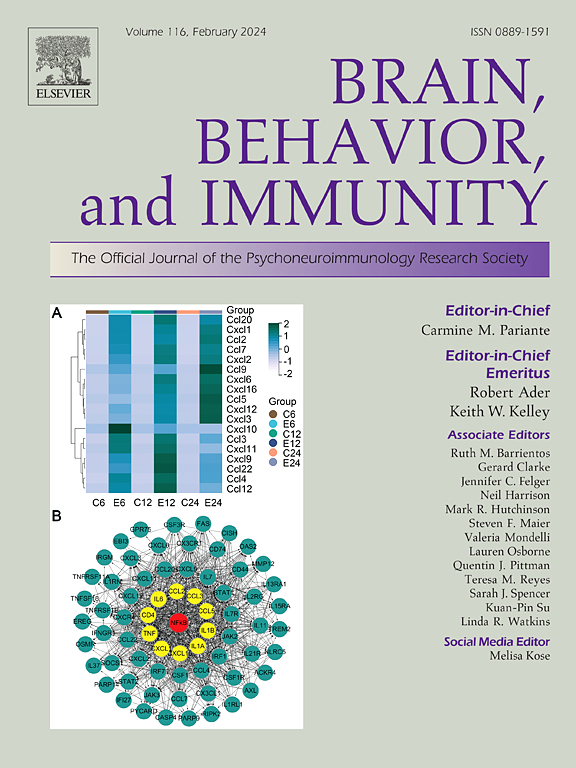重度抑郁症中的核因子卡巴-B细胞(NF-κB)、干扰素调节因子和糖皮质激素受体通路激活:巨细胞病毒感染的作用
IF 8.8
2区 医学
Q1 IMMUNOLOGY
引用次数: 0
摘要
据报道,重度抑郁障碍(MDD)患者的主要免疫调节通路活动发生了改变,这被认为是亚组患者循环炎症介质升高的原因。然而,这些基因表达变化的驱动因素仍不清楚。病毒感染是免疫功能的一个潜在调节因子。在这里,我们研究了巨细胞病毒(CMV)(一种常见的疱疹病毒,已被证明是炎症性疾病的病理辅助因子)与 MDD 中先天性炎症反应关键协调因子的活性之间的关系。我们利用 RNAseq 分析了 79 名未服药的 MDD 患者和 80 名健康对照者(HCs)的基因表达差异。根据差异表达基因启动子中预先指定的转录因子结合基序的相对普遍性,我们采用了一种成熟的生物信息学策略来量化转录控制通路的活性。主要目的是描述免疫调节通路活性的诊断差异,并确定这些差异是否与 CMV 血清状态或抗体滴度(病毒再活化)有关。与 HCs 相比,在 MDD 组中观察到干扰素调节因子 1(IRF1)和核因子卡巴-B 细胞(NF-κB)通路的活性显著增加。转录本来源 使用细胞特异性参考转录本组进行分析表明,与 MDD 相关的转录本组变化主要来自髓系免疫细胞(经典和非经典单核细胞)。与 MDD 相关的糖皮质激素受体(GR)通路活性上调也较为温和。MDD组和HC组的CMV感染/活性与GR通路的激活关系不大,但与IRF1和NF-κB的活性无关;CMV最显著的特征是CD8+ T细胞群的激活和/或扩增。在控制了 CMV 抗体滴度或 CD8+ T 细胞数量后,与 MDD 相关的 NF-κB(而非 IRF1)活性的升高明显减弱。MDD中的NF-κB信号至少有一部分可归因于对CMV的细胞免疫反应,这表明CMV感染可能是导致抑郁症炎症的几种途径之一。MDD中抗病毒IRF-1通路的明显激活表明了病毒过程的作用,尽管这种特异性抗病毒作用并非针对CMV。本文章由计算机程序翻译,如有差异,请以英文原文为准。
Nuclear factor kappa-B cell (NF-κB), interferon regulatory Factor, and glucocorticoid receptor pathway activation in major depressive Disorder: The role of cytomegalovirus infection
Altered activity of major immunoregulatory pathways has been reported in major depressive disorder (MDD) and is thought to underlie the elevations in circulating inflammatory mediators present in a subgroup of patients. However, the drivers of these changes in gene expression remain unclear. One potential modulator of immune function is viral infection. Here we examined the relationship between cytomegalovirus (CMV), a common herpesvirus, that has been shown to be a pathological cofactor in inflammatory disorders, and activity of key coordinators of the innate inflammatory response in MDD. We used RNAseq to characterize gene expression differences in in 79 unmedicated individuals with MDD and 80 healthy controls (HCs). A well-established bioinformatic strategy was used to quantify transcription control pathway activity based on the relative prevalence of pre-specified transcription factor-binding motifs in the promoters of differentially expressed genes. The main aim was to characterize diagnostic differences in immunoregulatory pathway activity and determine if these were related to CMV serostatus or antibody titer (viral reactivation). Significantly increased activity of interferon regulatory factor 1 (IRF1) and nuclear factor kappa-B cell (NF-κB) pathways was observed in the MDD group compared with HCs. Transcript Origin Analyses using cell-specific reference transcriptomes indicated that the MDD-associated transcriptome changes derived primarily from myeloid lineage immune cells (classical and non-classical monocytes). A more modest MDD-associated upregulation of glucocorticoid receptor (GR) pathway activity was also present. CMV infection/activity across the combined MDD and HC groups was weakly related to GR pathway activation but not to IRF1 and NF-κB activity; the most salient signature of CMV was activation and/or expansion of the CD8+ T-cell population. The elevated MDD-associated NF-κB (but not IRF1) activity was markedly attenuated after controlling for CMV antibody titer or for CD8+ T-cell prevalence. At least some of the NF-κB signal in MDD may be attributable to the cellular immune response to CMV, suggesting that CMV infection may be one of several pathways contributing to inflammation in depression. The pronounced activation of the antiviral IRF-1 pathway in MDD suggests the contribution of viral processes although this specific antiviral effect was not specific to CMV. CMV may indirectly drive interferon responses by impairing T-cell control of other viral infections.
求助全文
通过发布文献求助,成功后即可免费获取论文全文。
去求助
来源期刊
CiteScore
29.60
自引率
2.00%
发文量
290
审稿时长
28 days
期刊介绍:
Established in 1987, Brain, Behavior, and Immunity proudly serves as the official journal of the Psychoneuroimmunology Research Society (PNIRS). This pioneering journal is dedicated to publishing peer-reviewed basic, experimental, and clinical studies that explore the intricate interactions among behavioral, neural, endocrine, and immune systems in both humans and animals.
As an international and interdisciplinary platform, Brain, Behavior, and Immunity focuses on original research spanning neuroscience, immunology, integrative physiology, behavioral biology, psychiatry, psychology, and clinical medicine. The journal is inclusive of research conducted at various levels, including molecular, cellular, social, and whole organism perspectives. With a commitment to efficiency, the journal facilitates online submission and review, ensuring timely publication of experimental results. Manuscripts typically undergo peer review and are returned to authors within 30 days of submission. It's worth noting that Brain, Behavior, and Immunity, published eight times a year, does not impose submission fees or page charges, fostering an open and accessible platform for scientific discourse.

 求助内容:
求助内容: 应助结果提醒方式:
应助结果提醒方式:


